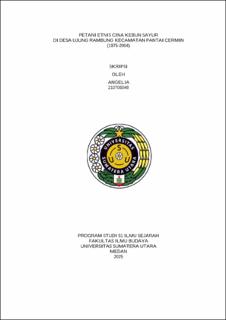| dc.description.abstract | This research discusses the Chinese Ethnic Vegetable Farmers in Ujung Rambung
Village, Pantai Cermin District, Serdang Bedagai Regency from 1975 to 2004.
This research aims to explain the existence of the Chinese ethnic group in this
area, which is inseparable from the large wave of migration that occurred from
the late 19th century to the early 20th century, closely related to the labor needs in
the East Sumatra tobacco plantation sector. After completing their contract or
free laborer work, most Chinese immigrants chose to settle permanently,
including in Ujung Rambung Village. Since around 1942, the Chinese community,
particularly those from the Hai Lohong clan from Hainan, began to build a new
life as vegetable farmers. This research uses a historical method with a
qualitative approach that includes heuristic, source criticism, interpretation, and
historiography stages. Primary data was obtained through field observations and
interviews with Chinese-descendant farmers and village officials, while secondary
data was collected from literature studies, including books, scientific articles, and
archives. The research results show that the profession of vegetable farmer is
maintained not only as a source of livelihood but also as a heritage passed down
through generations. This agricultural activity has developed more intensively
since 1975, and the term “vegetable garden” has emerged, locally referring to
agricultural areas managed by the Chinese community that consistently cultivate
various types of vegetables. The term “Chinese Vegetable Garden Farmers” has
also emerged to describe the identity of this group, which relies on the vegetable
farming sector for their livelihood. The research results explain the background of
the Chinese community in Ujung Rambung Village in choosing the profession of
vegetable farmer, the form of agriculture run by the Chinese Vegetable Garden
community, and the reasons why the Chinese community maintains the profession
of vegetable farmer. Additionally, the sustainability of this agricultural activity is
strengthened by social bonds among community members, the use of simple
agricultural technology, and limited alternative livelihoods in the village area.
This research concludes how the Chinese community in the village is able to
preserve a tradition passed down through generations in the farming profession
in Ujung Rambung Village, Pantai Cermin District. | en_US |


